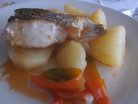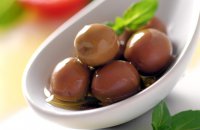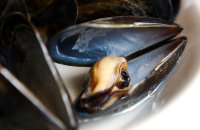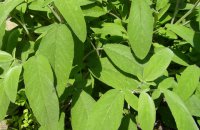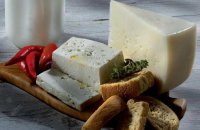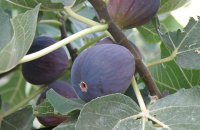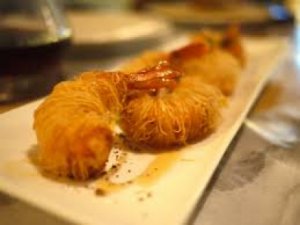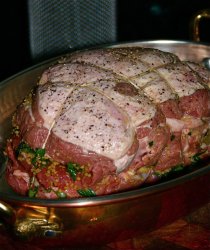There are innumerable versions of halvah. Basic halvah, as it is found throughout the Balkans and Turkey, is a simple dessert. The most common version is made by cooking semolina and then shaping it into balls which are then sweetened with either honey or "pekmez" (petimezi)- grape must syrup.
For Greeks, halvah is one of the main Lenten sweets, especially the variety made with tahini and sold in block or brick form. This type of halva is called Makedonikos Halvas (Macedonian halva). It is sold by weight and comes plain, flavored with chocolate, or studded with nuts. Greeks like to eat Makedonikos halvas sprinkled with lemon juice and cinnamon and often accompanied by a cool glass of retsina.
There are at least five or six other versions of halvah in Greece, though. The most interesting recipes are the obscure cheese-based halvahs found in some parts of northern Greece as well as in several Aegean islands. In these versions, fresh sheep’s milk cheese is slowly heated until most of its fat is exuded. It is mixed with sugar and sometimes a little flour. The dish is continuously stirred over a low flame until it becomes almost liquid, but still thick- a kind of primitive fondue.
Tasty, too, are the grain-based halvas from Thessaly. One old recipe, "sousamohalva," calls for sesame paste (tahini), wheat starch, chick peas and sugar. Farsala, near Volos, is famous for its smooth-textured halvah known either as sapoune or as "Halva Farsalon." It is made with rice flour and is opaque and unctuous with a crisp tasty topping of burnt sugar. There is the hard, white "kommat halvas," very similar to nougat, which is studded with walnuts, and which is found in bakeries in Salonika. "Halva tis Rinas" is a baked semolina version, the most common kind of halva and the one usually found in the home kitchen.
Although halvah is found all over Greece, it seems most likely that the etymology and perhaps the origins of the dish are Turkish. According to the "Classical Turkish Dictionary," the word in Turkish means sweet, but has evolved over time to be associated mainly with the name of the particular sweet in question. In the "Turkish Cookbook," Nevin Halici writes that halvah -or "helva" as it is called in Turkey- is the oldest dessert in Turkish cuisine. Mention of the dish is made in the 13th century works of Mevlana Jalaluddin-i Rumi, who conceived a philosophy of harmony and cooperation and provided much information on the subject of food. Many dishes are described in Mevlana's works, among them two versions of helva, one made with grape syrup called "pekmez helvasi" and one made with almonds called "badem helvasi."
In the 15th century, during the reign of Sultan Suleyman the Magnificent, under whose rule Topkapi Palace was greatly expanded to accommodate a more elaborate court life, the kitchens were rebuilt to include a structure with six domes called the Helvahane, or House of Helva, where, among other things, numerous varieties of halvah were made. By the 17th century, the elite of Istanbul were holding elaborate dinners called Helva suppers, perhaps not unlike the symposia of the ancient Greeks. At these Helva dinners, the sweet was served as a kind of intermezzo between sessions of discussion and entertainment. In some parts of Anatolia, to this day, helva suppers are still held.
Today, helva is still a very popular sweet in Turkey, consumed on special occasions, but especially eaten to mark births and deaths. There are several versions to be found. One is a loose pudding made with semolina into which is stirred sweet hot milk. It is seasoned with saffron and pistachios. The funerary dish is "Kara Topak Helva," which is made by browning flour and sesame seeds in butter and adding hot pekmez syrup and walnuts. The mixture is kneaded like a dough and served warm. (There is a Turkish saying, "He carries the halvah pan on his shoulders," which connotes that someone is dying.) Another version, "Un Helvasi," is made by slowly browning flour in butter, then adding a sugar syrup and pine nuts, not almonds or pistachios. "Irmik Helvasi," is a granular pudding also made with semolina and hot milk. Halvah is a favorite votive gift among Turkish women.
There are disputes as to when the dish, or at least its name, seems to have moved south and east from Turkey, into Syria and Lebanon, the Gulf States, Afghanistan, and, finally, India. Some sources say that Turkish emigrants, not Ottoman conquerors, brought it to the Arab countries a mere hundred or so years ago. Most agree it was introduced into India by the Moguls in the 16th century.
In the Gulf States, "halwa," might be made with corn flour, butter, sugar, nuts, cardamom, and saffron, and served in small containers like individual puddings. It is one of the most frequently consumed sweets, usually had with coffee and served to visitors. One also encounters the tahini-based version, to which is added an emulsifier called saponin, an extract from the roots and bark of a tree called Saponaria Officinalis. This version is known as "rahash" in the Gulf and as "halwa shamiyah" in the countries of the Maghreb. In Bahrain, Kuwait, and Qatar, we encounter the "sembosa helwah," a sweet made with ground almonds, sugar, cardamom, saffron, rosewater, flour, oil, and water. The ingredients are kneaded together and fried, and the dish is frequently prepared for wedding feasts.
In Iran and parts of Afghanistan, halvah is sometimes translated as saffron cake, and is most often made by browning flour in a skillet as one does to make a roux, then adding to it a sugar syrup flavored with saffron, rosewater, and cardamom. The mixture is spread in a shallow dish and garnished with pistachios. Oddly, in Iran it sometimes is served as a main course with a wedge of the Persian flat bread called "lavash," and it is also one of the dishes with which to break the Ramadan fast. Similarly, Iranians make a liquid form of halvah with the same ingredients but three times the amount of water, which they will then serve hot.
Some versions of the dessert, like the helwhaat el Jibni of the Lebanese, include cheese. In a most unusual recipe, a soft fresh cheese is poached in water and then drained. Semolina and some syrup are added to it. The mixture is spread into a shallow baking sheet, rolled up, cut into strips, and then dipped again in syrup. Nikos Stavroulakis in his book "The Cookbook of the Jews of Greece" also mentions a cheese halvah, from Hania.
Of all the countries of the East, though, India possesses by far the most unusual recipes for this most popular, widespread sweet. The Indian Sooji Halwa contains many of the same ingredients most Greeks associate with halvah, including semolina, sugar, and butter. But the wheat-colored dessert, Indian style, is studded with black raisins and is redolent of cardamom. It is the most commonly prepared dessert in Indian homes, oftentimes served with a dollop of heavy cream poured over it, as one of the main foods given to nursing mothers. Some of the most unique and delicious Indian halwas are the ones made for banquets and feasts. One calls for carrot simmered in coconut milk for hours until it becomes a delicate pudding. Another banquet preparation is the pumpkin or gourd halwa and the banana halwa (also found in Turkey). But perhaps the most unusual Indian recipe of all is the "dhall halwa," made with black lentils, semolina, rose water, coconut, and almonds.
































